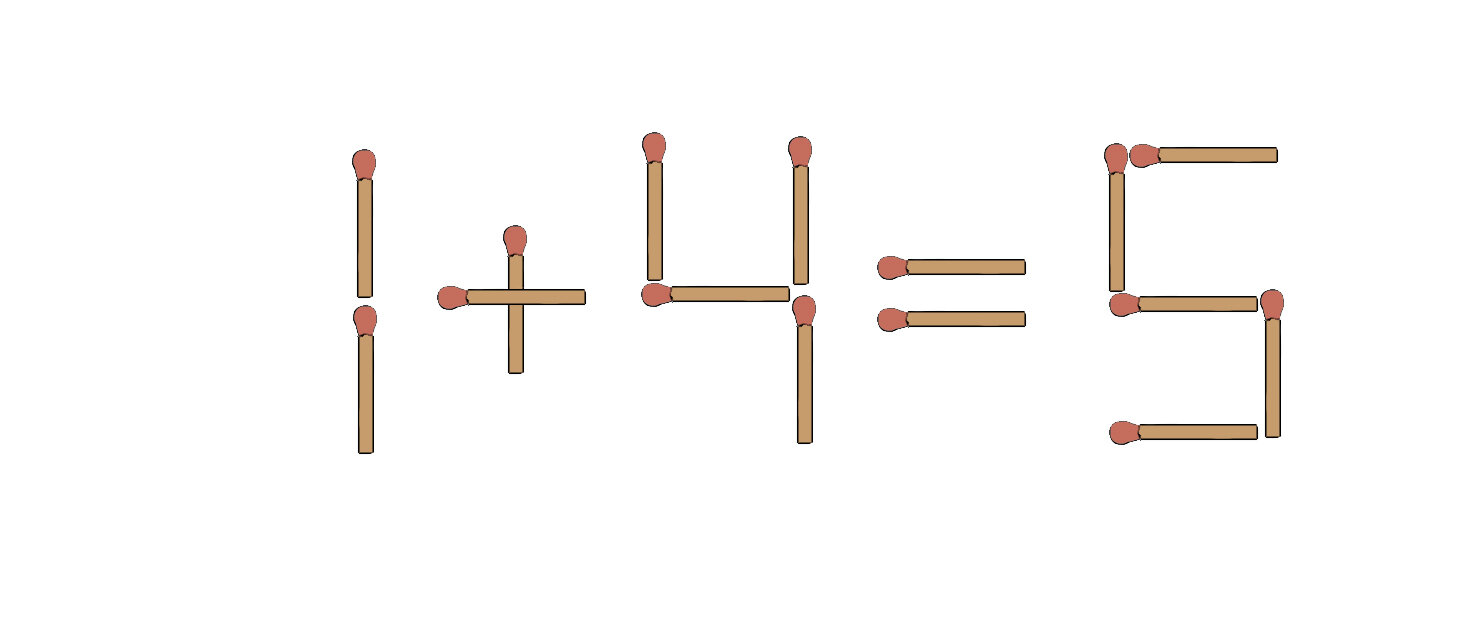Puzzles are a Designer's Best Friend
Before you read on try to solve this puzzle:
Seriously.
Take a few seconds or a few minutes and solve it. Once you’re done, then you can keep scrolling down and continue reading….
Okay. Assuming you solved it (and didn’t cheat) you might have come up with one of these two answers:
My bet is that 99 percent (or more) of you found only one solution – maybe the first solution (i.e. 1+4=5) and maybe the second (i.e. 7-4=3). Few of you solved for both. We tend to think there must be only one solution. Am I right?
Perhaps you’ve seen these types of problems before and were aware that the operator symbols (“+” or “-”) could be easily changed. Or perhaps you’ve stared at a digital clock long enough in the morning (when a parent was hounding you to get out of bed) and you started noticing the digital numbers can be altered by turning on or off just one (or more) of the 8 segments, to make a new number.
But you probably DIDN’T discover both of the above solutions before continuing on and reading the rest of this article. That’s human nature. We tend to move on too quickly when discoveries, innovations, and life-changing designs and decisions might be just a few more thoughts away. How many times have you said to yourself: “Why didn’t I think of that?”
The neat thing is that somebody somewhere DID think of that amazing thing. Somebody took a little more time, a little more thought, performed a few more experiments, and asked: “What else here is possible?” That individual is now known as the inventor of that thing. They went the extra mile and worked something a little bit longer than anyone else.
Let’s do another one. In the following word search: How many times does the word DESIGN appear (up, down, forward, backward, or diagonal- in the four different ways):
Did you quit after finding 5? Go back and try some more.
Did you quit after finding 6? Go back and try some more. It’s only a 10 by 10-word search. Come on…
What’s the answer? It’s 9. The word “DESIGN” appears 9 times in the above word search. Don’t believe me? Keep looking. They’re there.
If you are like most people you probably quit early. (But hopefully, you’re not like most people). I don’t know if you quit or found all 9 but this was only a 2 or 3-minute task. What happens when you need determination and perseverance for 2 to 3 years? Or 2 to 3 decades? It’s no surprise that some of the best things in life take time. Some of the best designs take time, too.
So how can you accelerate that process if 2 or 3 decades seems too long? Have a strategy, have a method, have a technique. And then apply it. For example, some of us might have simply focused on the “D”s. If you go line by line and simply check each “D” as the start for the word “DESIGN” in each of the 8 directions, you can quickly finish this task. It still takes work but it’s robust. It works. You can select a different letter of course (like the “N” or “I”), but the important part is to have a plan, work that plan, and stick to that plan.
All right. Final puzzle. Sort of. Take a look at the following image. Do you see one animal or two animals?
Maybe you’ve seen this one before, but there is a frog AND a horse in this picture. If you can’t see the horse, turn your head clockwise 90 degrees (or rotate the picture counter-clockwise 90 degrees) and you should see the horse.
Great designers, artists, engineers, and inventors see things in new ways. They look at the same object, the same product, or the same process and try to perceive it differently. When that happens great things can result. I love a scene in the movie, Big Hero 6, where the protagonist’s brother grabs him and then shakes him while holding him upside down. It’s not surprising this is where the protagonist has a eureka moment and then makes something awesome… (Go watch it!)
Looking at a thing with new eyes in new ways from new angles is an essential skill to develop in order to design or invent something new. The person who can perceive something differently can do wonders (and design wonders!).
Puzzles are indeed a designer’s best friend. In fact, every design could be considered a puzzle, with a key that needs to be found to unlock the door to innovation. Although I didn’t discuss classical puzzles where one needs to integrate 500 or 1000 interlocking pieces to create a full picture, (there are some key lessons there), the puzzles shown above have some important lessons too. Indeed, just like with puzzles, a designer must stick to a task, work a plan, and look at things differently.
The next time you have a few moments instead of checking social media, practice becoming a better designer and do a puzzle!
To cite this article:
Salmon, John. “Puzzles are a Designer's Best Friend.” The BYU Design Review, 25 Jan. 2021, https://www.designreview.byu.edu/collections/puzzles-are-a-designers-best-friend.










